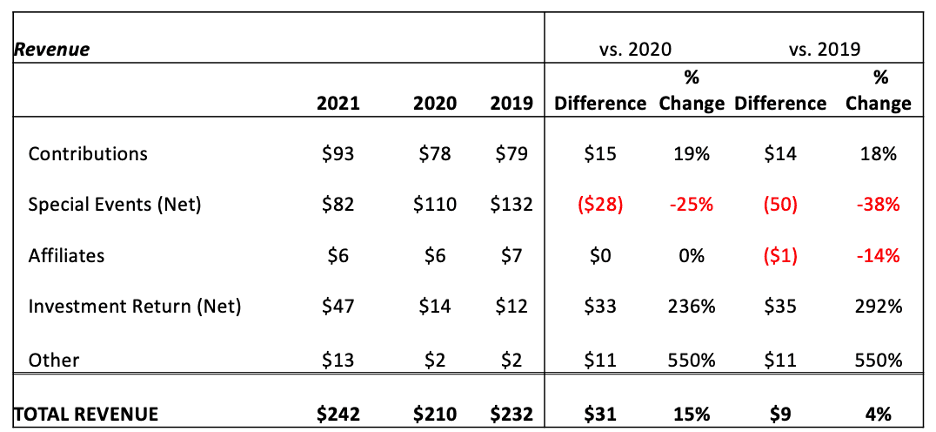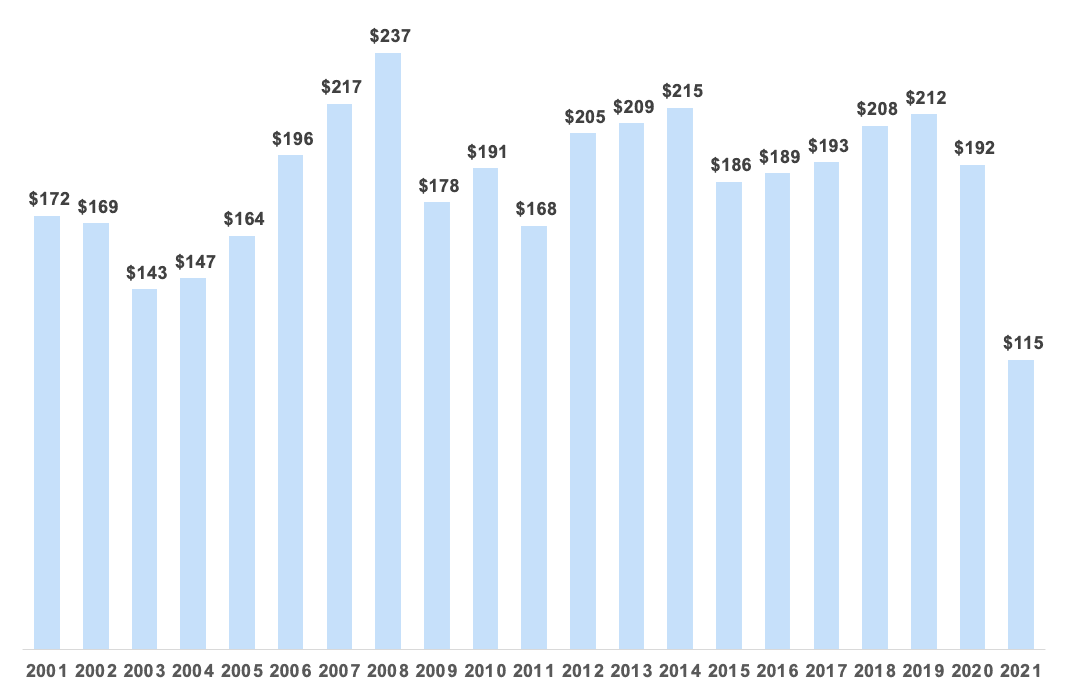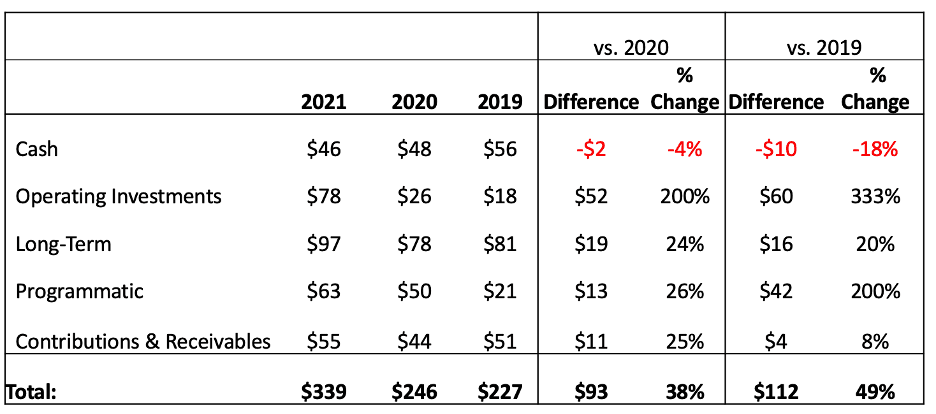July 14, 2022
JDRF’s 2021 Fiscal Year endured the full force of COVID-19, stretching from July 2020 to June 2021. During this period, many organizations saw a contraction in revenue and, in response, reduced expenses substantially.
JDRF cut expenses but, at the same time, surprisingly, experienced near record-high income. Expenses were reduced by nearly half compared to 2019, the year before COVID, following the conservative and prudent financial approach of most organizations at the time. Income, on the other hand, soared to $242 million, the highest reported level since 2001. This report will explain how expenses were used; what drove the record income; and point out potential long-term implications for both.
The disparity between income and expenses led to a record build-up of cash and short-term investment reserves. At the end of 2021, the JDRF had a $124 million build-up of cash and short-term (“operating”) investments (See Appendix). This money is obligated to be used to further the mission of JDRF and its deployment presents both an opportunity and a challenge in the years ahead. As a “war chest,” it can be used to turbo-boost promising research, preferably research that accelerates a functional cure for T1D.
This moment of crisis presents JDRF with an opportunity to deepen its commitment to the areas which are most important to T1D donors. With the expense base cut to its lowest level in 20 years and with a cash war chest as large as ever, the JDRF is in a unique position to re-assess priorities and re-allocate resources. In our view, it is a great time to double down on cure research.
Income: Record-breaking but Unsustainable
Total organization revenue, which combines both JDRF and the JDRF T1D Fund, reached $242 million in 2021, the highest level since 2001. However, much of this record-setting income was driven by gains from the T1D Fund, the venture philanthropy organization connected to JDRF, whose revenue will be sporadic and restricted to the Fund.
The JDRF T1D Fund is a subsidiary of JDRF International, but has its own board of directors and could be considered separately from the parent organization. The fact that the financial statements are combined with only some information clearly delineated adds some complexity to this review. Because JDRF chose to share revenue data from the T1D Fund in FY 2021 – but not FY 2020 or 2019 – we cannot compare the revenue of JDRF International minus the T1D Fund.
Revenue Highlights
- All-in, JDRF raised $242 million in FY 2021, a slight increase since FY 2019, the year before the pandemic. See Chart 1.
- JDRF International raised $184 million through its traditional fundraising sources (minus the revenue from the T1D Fund).
- JDRF T1D Fund raised $57 million in FY 2021
- $30 million of contributions were raised by individual donations to a capital campaign. This type of capital fundraising campaign occurs when a venture fund seeks to expand is impact and is distinctly not a perennial event. Furthermore, this income stream is restricted to use by the JDRF T1D Fund.
- $27 million in returns on investments made by the JDRF T1D Fund (one of the Fund’s investments, Pandion Therapeutics sold to Merck for approximately $1.85 billion). Again, such returns will happen every so often but are distinctly not perennial.
Chart 1: JDRF Revenue Sources, FY 2019-2021 (in Millions)

- -38% two-year drop in revenue from special events, presumably due to the challenges of meeting in person during COVID.
- -14% two-year drop in revenue from affiliates, organizations associated with JDRF international.
- 18% two-year gain in revenue from contributions from donations to JDRF International and the JDRF T1D Fund.
- 292% two-year increase in revenue from investment returns, meaning proceeds from the liquidation of stock, from JDRF International and the JDRF T1D Fund.
- 550% two-year increase in other forms of revenue.
Uses of Money: Financial Discipline During Uncertain Times
Chart 2: JDRF Total Expenses, FY 2001-2021 (in Millions)

During 2021, because of COVID-19, JDRF cut spending by nearly half from 2019. See Chart 2. Many other organizations concerned about the general state of the economy also made deep cuts during 2021; JDRF was not an exception. While extremely challenging, this move showed financial discipline and helped ensure that the organization was not overwhelmed by the crisis.
We view the spending trends during this year as an exception and fully expect that the decreases in support of key T1D mission areas during this period will be restored in the years ahead. Of the major expense areas shown in Chart 3, all decreased significantly from the prior year except for fundraising costs.
Chart 3: Program Expense Breakdown: FY 2021 vs. 2020 (in Millions)

Research grants were significantly reduced from $69 million to $29 million between FY 2020 and 2021. This is the lowest level of research grant spending in 20 years (See Chart 4). A spokesperson for JDRF explained that the massive drop in grant funding in FY21 was partially because many multi-year grants were paused by COVID, and the organization was reluctant to enter new multi-year grant agreements during the uncertainty of the pandemic. JDRF further stated that we will see a “dramatic increase” in research grant funding reflected in FY22, which ended on June 30 of this year.
Chart 4: JDRF Research Grant vs. Non-Research Grant Spending, FY 2001-2021

Another look at JDRF functional expenses, shown in Chart 5, clearly show the impact of COVID. All expense categories, except for occupancy (office rent), decreased significantly from 2019. Here are a few of the highlights of 2021 versus 2019:
Chart 5: JDRF Functional Expense Breakdown: FY 2019-2021 (in Millions)

Appendix: JDRF Liquidity, FY 2019-2021 (in Millions)

